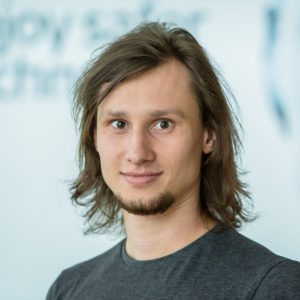Jakub Mertus
Tatra banka

What happens when research, its practical applications and human factor intersect? How to train the machine learning models to expect the unpredictable events that are inevitable in real life? This time we’ll look at the challenges the AI and ML technologies face when put to practical use.

Tatra banka
Jakub Mertus is a venture builder and data scientist in Tatra banka with physics background, who is working at transferring machine learning into actual operations. He will show us his experience of devising and implementing a trading algorithm in the asset management arm of Tatra banka.

George Mason University
Jana Kosecka is a Professor in the Department of Computer Science at George Mason University, where her research explores computer vision, robotics and AI. She will talk about approaches to using machine learning for computer vision, how to effective model AI powered human-robot interactions and how to help machines make decisions in open-ended domains and untrained situations.
Language: English

During the 11th volume of Better AI Meetup, we will be talking about how to successfully use AI to identify, qualify and rate online content, spot fraudulent activities and data and make sense of vast amounts of data available.
Our presenters will show us how they use AI & LLMs to spot generated content or misinformation and how LLMs can be harnessed to produce structured, verified, actionable information out of the available data.



The AI Act is quickly becoming a reality, affecting every company and researcher that has something in common with AI. What to expect from the upcoming legislation? Who will be affected? How to prepare for the impact of the regulation?
Our guests will be talking about how to use the AI Act to create trustworthy, responsible AI applications as well as how to proactively prepare companies and research teams for the regulation. There’s no better place for such a discussion than the Better AI Meetup!




Medicine is still regarded as the domain where humans rule. But AI is proving a valuable tool in their hands. If used correctly, it has the potential to see better than the best-trained physician and can spot problems before they grow too dangerous.
First, we will be talking about the advances AI has already reached in radiology and what opportunities it can bring in the very near future. Next, we will see the challenges of designing a medical AI so that it passes the regulatory approval.
Join us to see how AI will be helping you get healthier in the coming future!




Having conversations with AI is being touted as the future of our communication with computers. For the conversations to be both meaningful and easy to understand, they need to be properly trained in as many languages as possible, including those with smaller numbers of speakers. Also, the cheaper the training, the better.
During the 8th Better AI Meetup, we will be addressing exactly these challenges: evaluating quality of language models, training those models without breaking the bank and the future expectations from language models in the business and elsewhere.




The explosion of ChatGPT and GPT4 into mainstream applications may seem like we have solved all there is regarding language. However, there are still challenges that AI struggles with.
In this edition of Better AI Meetup we will be talking about speech processing as well as designing ways to evaluate machine learning algorithms for accuracy and speed and choose a proper one for a particular use case.




The advent of generative models such as DALL-E, Midjourney or Stable Diffusion have brought a deluge of AI-generated images. The question we want to answer is: How to harness their power for innovative uses that improve quality of life?
We will present two practical examples on how to use generative AI for improving datasets for machine learning.
Lukáš will show us how to use AI for annotation and labeling of large datasets, while Igor has developed novel ways to generate fingerprints for training fast, accurate models for fragmented fingerprints. In both cases, AI is helping improve the accuracy of models that then help automate administrative processes or even solve crimes.




Machine Learning is used not only to detect new malware, but also to create more efficient, harder to detect threats. Will the pros of machine learning outweigh the cons or will the cybersecurity equilibrium deteriorate? And how to explain what the AI does when it makes decisions? This time, we will look at outsmarting cyber-criminals as well as understanding the AI itself.



Ever wanted to start utilizing federated learning? Professor Peter Richtarik from King Abdullah University of Science and Technology will give us a detailed lecture on the role of local training in federated learning and will answer any questions you may have.
Federated Learning refers to machine learning over private data stored across a large number of heterogeneous devices, such as mobile phones or hospitals. In an October 2020 Forbes article, and alongside self-supervised learning and transformers, Federated Learning was described as one of three emerging areas that will shape the next generation of AI technologies. In this talk I will explain how we recently resolved one of the key open algorithmic and mathematical problems in this field.


What happens when research, its practical applications and human factor intersect? How to train the machine learning models to expect the unpredictable events that are inevitable in real life? This time we’ll look at the challenges the AI and ML technologies face when put to practical use.




This time, we want to give you insight into how AI and machine learning methods are put to practical use at Innovatrics for training new biometric algorithms and in Swiss Re, one of the largest re-insurance companies in the world, to develop new, innovative products.
Machine learning (ML) helped us to solve such complex tasks as face recognition, however when it is done on a large scale it relies on many high-effort data management tasks. We will describe our winding road from images in folders and labels stored in CSV files to structured versioned datasets with reproducible data processing pipelines. Moreover we mention how we deal with data versioning / validation / quality evaluation, reproducible ML trainings and experiment management.



The opening presentation is centered on the most recent success of AI research in Slovakia – the SlovakBERT model. Creating a neural language model for languages with limited available corpus can be challenging. We will explain what are the main obstacles when creating such model and what its practical applications are. The second presentation will focus on why AI is becoming mainstream and what it means for the future of the technology.


